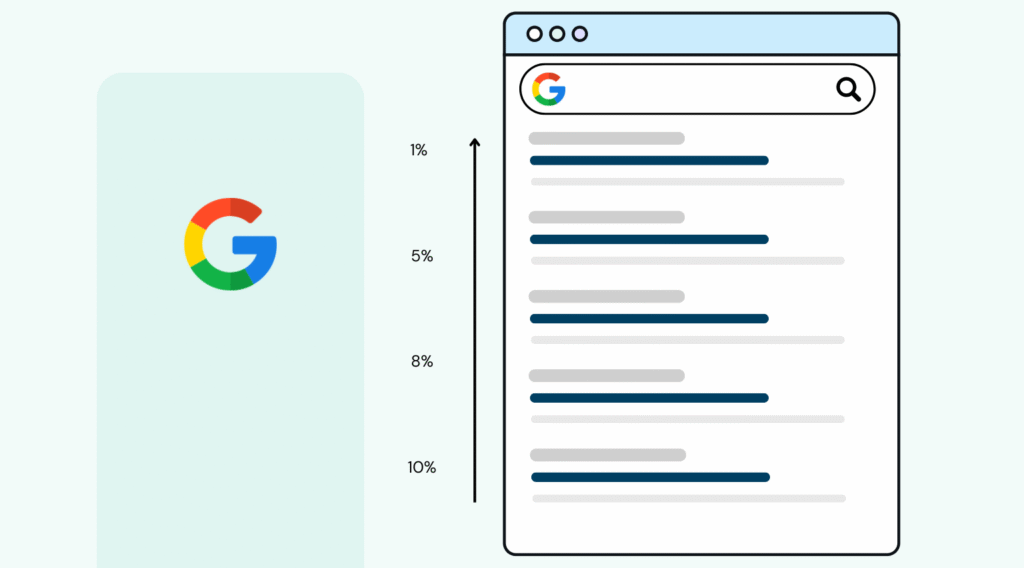SEO, or Search Engine Optimization, is the process of optimizing a website to improve its visibility on search engine results pages (SERPs), making a website easy for search engines to find, understand, and rank on first page for people to find who are searching for relevant information – meaning without paid ads. It involves optimizing a website’s technical setup, content relevance, and external link popularity to help search engines better understand the site and rank it higher for relevant user queries. This makes it easier for users to find the website when searching for information, products, or services online.

SEO changes over time because search engines change, devices change, and people change the way they search. It’s critically important because it drives qualified, organic traffic to websites, which can lead to increased brand visibility, customer engagement, and conversions. SEO provides a sustainable way to build long-term online presence and trust. Effective SEO aligns website content with what users seek, improving user experience while meeting search engine criteria. Since search engines are a primary way people locate what they need online, a strong SEO strategy helps businesses connect with their target audience and grow their digital footprint over time.
What is SEO?

SEO is continually evolving due to rapid changes in technology, user behavior, and search engine algorithms. In recent years, trends like AI-driven search, visual and voice search, and the increased importance of user experience have reshaped how SEO works. For example, search engines in 2026 now heavily utilize artificial intelligence to interpret user intent, prioritize high-quality and contextually relevant content, and reward sites offering superior user engagement metrics such as interaction and page load speed.
How SEO connects users with relevant content.
Search engines use crawlers to discover pages, render content (including JavaScript), index pages into a searchable database, and then rank indexed pages when someone queries. Optimizing content and technical structure increases the chances that the engine will interpret your page correctly and show it to the right users. That connection — from query to answer — is the core value proposition of SEO.
Goals: Ranking, visibility, and qualified traffic
The three practical goals most teams measure are:
- Ranking: Appearing prominently for target queries.
- Visibility: Showing up in SERP features (knowledge panels, snippets, shopping carousels) that attract clicks or attention.
- Qualified traffic: Bringing visitors who are likely to complete desired actions (conversion, sign-up, purchase).
Good SEO aligns page purpose with user intent and measurable business outcomes.
SEO vs. SEM vs. PPC
Search Engine Marketing (SEM): It works like an umbrella for those kinds of activities that increase visibility in search results. SEM comprises both organic strategies (SEO) and paid strategies (PPC).

Differences and similarities among SEO, SEM, and PPC
- SEO: This is the foundation of organic growth. It’s a long-term strategy focused on earning your place in search results through relevance and authority. The traffic you gain is sustainable and continues to compound over time, making it a high-return investment.
- PPC: This is the paid advertising component of search. You pay for a top position in the search results. The visibility is immediate but stops the moment you stop paying. It’s ideal for testing new markets, promoting time-sensitive offers, or targeting highly competitive keywords.
- SEM: This is the umbrella term that encompasses both SEO and PPC. A balanced digital marketing strategy uses both: PPC for immediate demand capture and testing, and SEO to build a durable, low-cost traffic engine for the future.
Both channels rely on keyword and audience understanding. Where they differ is timing, cost profile, and long-term impact. A balanced program uses PPC for testing and immediate demand capture, and SEO to build a durable source of low-cost traffic.
Why using both organic and paid strategies is ideal
Paid search can validate keywords and funnel immediate users. Those insights make SEO more efficient. Conversely, strong organic rankings reduce long-term acquisition costs. The two channels amplify each other when coordinated.
Why Is SEO More Important Than Ever in 2026?
Organic search’s share of traffic: Organic search remains one of the largest sources of qualified traffic for most websites. Studies show that over 90% of online experiences begin with a search engine, and the vast majority of clicks go to the organic results on the first page
Where users start their product searches: Search behavior for product discovery is fragmented. Many shoppers begin on marketplaces and retail platforms rather than a general search engine. Recent data indicates a large share of U.S. consumers start product searches on Amazon, which changes how ecommerce brands prioritize channels. If you sell products, discoverability on marketplace search engines is part of modern SEO planning.
SEO’s competitive and sustainable advantages: SEO builds compounding value. Paid traffic stops when budgets end. Social visibility can be fleeting. Well-executed SEO continues to attract users and reinforces brand authority over time. It also integrates with other marketing activities: content you optimize for search fuels social, email, and paid campaigns.
Role in earning trust and authority: High-ranking pages are often perceived as more trustworthy. The work SEO forces you to do – prove expertise, present accurate content, and maintain a solid technical foundation – also improves user experience and brand credibility.
The Three Pillars of Modern SEO
SEO splits into three primary pillars and several specialized disciplines.
Core pillars
- Technical SEO: Site architecture, crawlability, indexing, speed, mobile readiness, and structured data. This ensures search engines can discover and interpret your content. [ Ensuring site crawlability, mobile-friendliness, page speed, indexing, and secure connections (HTTPS)]
- On-page SEO: Content, headings, metadata, internal linking, and on-page structure that match user intent. [ Optimizing title tags, headers, content for user intent, internal linking, and using structured data]
- Off-site SEO: Links, brand signals, PR, reviews, and third-party citations that help establish domain authority and trust. [ Earning high-quality backlinks from other sites, positive brand mentions, and reviews]
All three matter. Technical problems can block even the best content; poor content cannot rank without relevance; and off-site signals often determine competitive ranking differences.
Specializations (brief)
- Ecommerce SEO: Product and category optimization, faceted navigation handling, product schema, and review integration.
- Enterprise SEO: Governance, workflow, and automation for very large sites and multi-team organizations.
- International SEO: Language, region targeting, hreflang, and local search engine nuances.
- Local SEO: Google Busin
- ess Profile management, local citations, and reputation signals for geographically targeted queries.
- News SEO: Speed to index, news schema, and discovery in “Top Stories” and Google News.
Each specialization adds tactics on top of core best practices.
How SEO Works: The Six Core Elements
Below is a practical framework that explains how SEO operates day-to-day.
Understanding search engines (Crawling, Indexing, Ranking)
Search engines crawl the web, render pages, and store page data in an index. Ranking algorithms then score those pages for relevance and quality. Modern search includes AI components and specialized SERP features, so optimization now accounts for both classic ranking signals and how results are presented to users. It index those pages into a massive library, and rank them in response to a query based on hundreds of factors like relevance, quality, and usability.
Mobile-first indexing means search engines evaluate mobile pages as the primary source for ranking and indexing. Make sure your mobile content matches your desktop content.
Research (Audience, Keyword, Competitive, Website, SERP Analysis)
Research is foundational:
- Audience & Keyword Research: Identify the topics, questions, and keywords your potential customers are using. Tools like Semrush and Ahrefs can help you find valuable, low-competition opportunities
- Keyword and topic research: Find queries with intent and feasible competition.
- Competitive research: See what’s working for the sites already ranking for your target terms.
- Website audits: Detect crawl, indexation, or speed issues.
- SERP analysis: Look at the search results page itself. Are they dominated by videos, featured snippets, or product listings? This tells you what kind of content you need to create.
Strategic Planning (Goal-setting, Strategy, Tools, KPIs)
Strategy ties research to measurable outcomes. Set SMART goals, choose KPIs (organic revenue, conversions, impressions), and document priorities. Decide which pages to create, improve, or retire.
- For Technical SEO: Fix crawl errors, improve page speed, and ensure your site is secure.
- For On-Page SEO: Create comprehensive content that satisfies user intent. Use clear headings, and optimize elements like title tags and meta descriptions.
- For Content: Focus on thought leadership—creating concise, skippable, and authoritative content that earns trust and provides a clear path for the user
Creating and Implementing (Content creation, Optimization, Updating)
Create content that answers user intent better than competitors. Use clear headings, answer top questions early, and structure content for scanning. Implement technical changes like canonical tags, structured data, and correct redirects.
Monitoring and Maintenance (Tracking performance, fixing issues)
SEO isn’t something you set up once and walk away from. Use tools like Google Search Console and Google Analytics to track your performance, spot indexing or traffic issues, and catch any drops early. Regularly update and refresh your content to keep it accurate and competitive. Monitoring performance and maintaining your site consistently helps prevent small technical or content issues from turning into major ranking losses.
Analyzing and Reporting (Using data, refining strategy)
Use your data to close the loop. Analyze what’s working and what isn’t. Run A/B tests on your title tags and content. Use these insights to refine your strategy and double down on what drives results.
How SEO Evolves
Technological changes: AI, mobile-first, speed, and UX
Generative AI features are now integrated into search results, producing summaries that users may see before the organic results. This shift means content should be crafted not only for ranking but for being useful to AI summarizers and to users skimming summaries. Google’s AI Overviews and similar features are now part of the search landscape and influence visibility.
Mobile-First is the Only Reality With over 60% of global web traffic coming from mobile devices, a flawless mobile experience is non-negotiable. Google has completed its shift to mobile-first indexing, meaning your mobile site is the primary version Google uses for ranking
Visual and multimodal search is growing. Image and video search, and “upload to search” features, make visual asset optimization more valuable.
Societal factors: behavior and platform shifts
People use different places to search depending on their intent. For product research, many users start on retail platforms instead of broad search engines. That affects where brands invest for product discoverability.
Economic shifts and other macro factors change demand patterns. SEO gives organizations the flexibility to adapt content to changing user needs without the immediate cost of paid channels.
Continuous change: why SEO is never “done”
Search engines, user behavior, and competitors all move. SEO is a continuous loop of research, implementation, and analysis. The companies that win are those that build efficient processes to iterate and learn.
How to Learn and Grow in SEO
Trusted resources: Start with primary sources: Google Search Central for how Google evaluates pages, and reputable industry publications for interpretation and case studies. Follow authoritative blogs, newsletters, and conference talks to stay current.
Experimentation and hands-on learning: Create a small site or run experiments on existing pages. Test title tag changes, content rewrites, or site speed improvements. Measure the results and document what works.
Community and ongoing education: Join forums, Slack groups, and local meetups. Attend at least one conference a year if you can; the community accelerates learning and provides real-world context to changes in search.
Practical Checklist (Quick)
- Verify mobile and desktop content parity; validate via Search Console.
- Fix critical Core Web Vitals issues.
- Map content to intent and update pages that used to perform well but have declined.
- Implement or validate structured data for pages where it adds value.
- Run backlink audits and prioritize earning relevant, editorial links.
- Track conversions from organic search, not just sessions.
Conclusion
SEO in 2026 is both familiar and new. The fundamentals — crawlability, relevant content, and reputation still matter. New realities generative AI summaries, mobile-first indexing, and platform-driven product search change how you prioritize work. The right approach is practical: focus on user value, measure impact, and iterate.
Start with a small, measurable project. Prove that SEO can move the needle, then scale.
Frequently Asked Questions (FAQ)
While many factors are important, satisfying user intent with high-quality, helpful content is paramount. Google’s advanced AI prioritizes content that best answers the user’s underlying question or need.
It typically takes several months to see significant traction. Google itself suggests waiting a few weeks to assess the impact of changes, and building authority is a long-term process.
They are equally important. The best content in the world won’t rank if technical issues prevent Google from crawling and understanding it. Conversely, a perfectly technical site with thin, irrelevant content has nothing to rank for.
AI has shifted the focus from keyword density to topic depth and user intent. It has also introduced new features like AI Overviews, where being cited as a source is a new form of visibility.